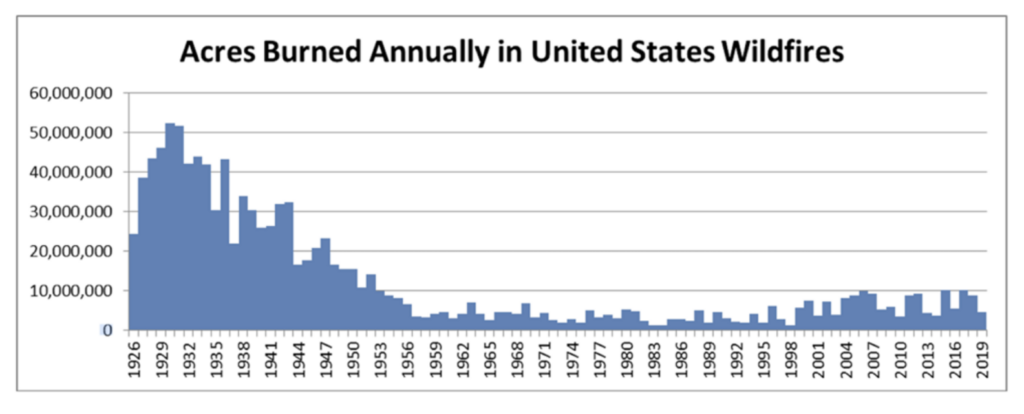Last Saturday, the Daily Sceptic examined the claim reported by Matt McGrath of the BBC that forest fires had nearly doubled in the last 20 years, and the “key factor” was climate change. We looked at the underlying data and found a more rational explanation was the improvement in the collection of satellite data around 2012. The story became the subject of a Twitter fact check by the Forbes climate writer Dave Vetter.
“Once again, climate denier Toby Young is trumpeting fossil fuel industry propaganda. This time it’s about forest fires. He links to his blog Daily Sceptic, a site where a handful of middle aged guys practice science illiteracy”.
One might raise a complaint that Vetter missed “white and pale” out of his introduction, but no matter. He says that I picked several studies to support the contention that there were fewer wildfires today than there were in the past. But Vetter ignored the central data point around which the story was constructed. The data on tree loss came from Global Forest Watch (GFW), which used a satellite feed from the University of Maryland. It was claimed over half the 9.3 million hectares burnt globally were to be found in Russia.

Above is the Russian graph on tree fire loss we published (taken from GFW). We reported that past results going back to 2001 were flat for a decade, then different reporting and modelling came in and, after an initial upward adjustment, they have been flat ever since. Far from global fire losses being “staggering” over the last 20 years, as faithfully reported by the BBC, it’s possible that they haven’t changed much over the period. That was certainly the opinion of the Royal Society in October 2020, which said there had been no overall increase in total area burnt by fire in the past two decades.
At this point, Vetter entered the fray. “Morrison claims there are fewer wildfires today than in the early 20th century, and cites a 2016 paper from Professor Stefan Doerr and Dr Christina Santin who conclude ‘there is less fire in the global landscape than centuries ago’.” Not mentioned by Vetter is the additional statement that the global area burned “appears to have declined over past decades”. Of course, I didn’t make the claim he attributes to me, but reported factually what the two academics had found. At least Vetter is accurate in reporting some of the academics’ views.
But he continued: “Curiously, Morrison doesn’t cite more recent work from Doerr and Santin, who this year wrote ‘wildfire risk has grown nearly everywhere’ and ‘the pace at which fire weather conditions are increasing is accelerating faster than climate models predicted’. Equally curious, it might be noted, is that Vetter is just quoting opinion to counter the “increasing evidence”, supplied by the same academics in 2016, that there is “less fire in the global landscape than centuries ago”. It’s true, however, that many academics go out of their way to stress ‘climate change’ in their work these days. The 2016 paper barely mentioned it. To all intents and purposes, the last statement about climate models is meaningless.
Finally, Vetter tops up the abuse, accusing the Daily Sceptic of “regurgitating the same old debunked lie in order to further their agenda”. The lie in question? This official US wildfires graph:

This graph has long been distressing for those who want to paint a picture of a world ablaze with uncontrolled fires caused by humans changing the climate. So distressing, it seems, that last year the National Interagency Fire Center removed all data before 1983 from its official record. No doubt by the sheerest of coincidences, the new 1983 start date is a convenient low point, so the mainstream media can report that wildfires have recently been increasing in the U.S.
There has been much debate about the validity of this data. Some argue record keeping was not as strict in the earlier part of the 20th century. Different agencies might have recorded fires twice, although others note that some fires would have escaped official notification. But we know that the 1920s and ’30s were prone to high levels of heat in the U.S., and prolonged droughts led to ‘dustbowl’ conditions. The overall downwards fire trend suggests numerous natural factors at work, and anthropogenic climate change is unlikely to have played a big part. Vetter points to a recent PolitiFact fact check in which it was claimed that the “best assessment suggests” that fires today are about on the scale the country saw in the first few decades of the 20th century. PolitiFact provides a list of sources to back up its claim. Many are detailed science papers, but there seems little sign of any serious attempt to cast doubt on the veracity of the full record.
Of course, Vetter can throw around all the abuse he likes. But wildfires are a natural, and vital, part of the Earth’s ecosystem. Humans do not cause fires by warming the planet, although they do ignite a vast number of them, either accidentally or on purpose. Biblical incantations of fire and damnation have always been popular with religious cults – the climate Thermogeddonites are just the latest in a long line.
Chris Morrison is the Daily Sceptic’s Environmental Editor.











To join in with the discussion please make a donation to The Daily Sceptic.
Profanity and abuse will be removed and may lead to a permanent ban.